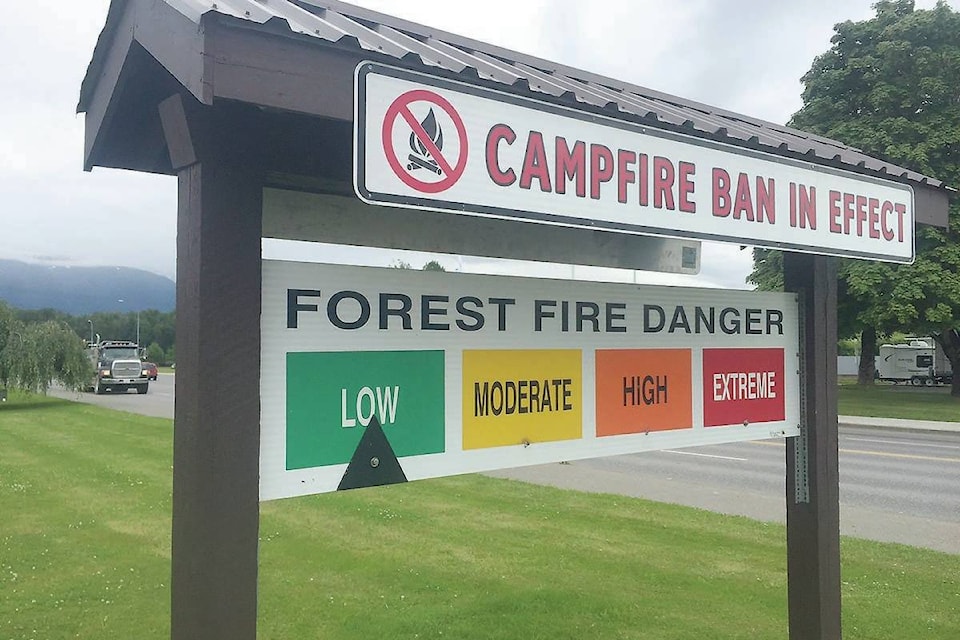Thornhill Fire Department is ready to send two of its trucks and half a dozen firefighters to the wildfires down south if needed, without the local area losing any of its fire suppression capabilities.
Fire chief Rick Boehm said the two vehicles that would be sent are a 2,500 gallon water tender and a fire engine, and two firefighters to staff the water tender and two for the engine.
Their readiness comes after the provincial government put out a request for assistance, he added. Fire departments register with provincial emergency services in the spring each year and now there’s definitely an uptick in requests for additional equipment and manpower, said Boehm.
The fire department first ensured it would have enough firefighting resources to extinguish blazes here and talked with the regional district, which gave the green light to Thornhill, he added.
“We would still have adequate resources here. That was a big requirement from the regional district administration to confirm we were not cutting ourselves short and we’d still be adequately protected,” said Boehm, adding deployment is usually for 14 days.
If Thornhill sent six firefighters and equipment to the wildfires, and needed assistance with fighting fires here, it could share the workload with the City of Terrace as well, added Boehm.
Any firefighters who would volunteer to go fight the wildfires would be taken on a first-come, first-served basis, although a minimum of training would be required, which might exclude new firefighters in the department, he said.
“These people (volunteers) would be on vacation, using their time off or vacation time or on a mutual exchange, said Boehm.
“Fourteen days is quite a stint to be away from work, family and holidays. They’re offering up a huge thing when they do this.”
Locally, Terrace is not getting much moisture, said Boehm.
“A lot of people think the little downspurts we get are adequate and take that chance of having an open fire but 1-2 mm doesn’t go very far,” he said.
The Fire Danger Rating here in Terrace was low as of July 11.
The City of Terrace issued an open fire burning ban July 10. Boehm said the regional district doesn’t issue its own burning ban, it matches what the province does.
Brian Doddridge, officer, communications and business development for the city, said its fire department is not offering any equipment but deputy fire chief Dave Jephson offered to help if someone with command-like experience is needed.
•••
The Terrace Salvation Army’s mobile food van is on standby in Prince George for any calls to travel to wildfire areas.
The truck was called to Williams Lake July 7 but the road was closed in Quesnel due to the fierce flames so the truck went back to Prince George, said Captain Deb VanderHeyden July 11.
“It’s difficult to bring food in with highways closed,” she said.
“We suspect it will be like Fort McMurray where it will take quite some time to feed the service providers and clean up the town so it could go on for quite some time when the fires are put out.”
•••
Northwest Fire Centre unit crews are helping battle the wildfires in the province.
Terrace’s Firebird unit crew is in the Cariboo fire centre along with the Rainmaker unit crew from Hazelton, the Ranger unit out of Telkwa and the Burns Lake unit crew.
That’s 20 people on each crew, who can be deployed for a maximum of 14 days, said Olivia Pojar, information officer for the Northwest Fire Centre, which stretches from the west coast to just west of Endako and from the Yukon border to Tweedsmuir Provincial Park.
Two of Terrace’s three initial attack crews have been deployed; the third is on its days off, she added.
One crew is in the Kamloops Fire Centre and one is fighting a fire about 33 km northeast of Granisle, said Pojar.
There’s also three initial attack crews based out of Telkwa and two in Houston, said Pojar.
“Initial attack crews are able to respond quickly to wildfire starts in each fire zone within the fire centre via helicopter deployment, and can be immediately reassigned from one wildfire to another of higher priority as and when needed,” she said.
Former initial attack crew member and zone wildfire officer for the Terrace base Tony Falcao moved to a new position of deputy fire centre manager this past spring but is currently deployed to the Cariboo Fire Centre to help coordinate the response to the fires of note there, added Pojar.
Weather is monitored multiple times every day and the data is used to make decisions of where to send fire crews, she added.
The Northwest Fire Centre also talks with the other fire centres and the provincial coordination centre as well.
